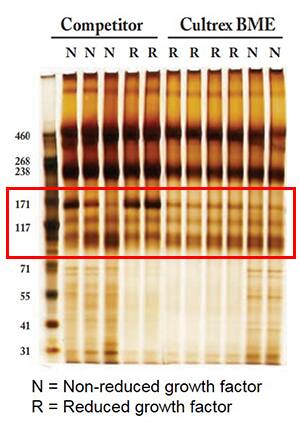5 Reasons Why the Cultrex Brand Is Essential for 3D Cell Culture
When Bio-Techne acquired Trevigen we expanded our offering of Cultrex® Basement Membrane Extract (BME) and Cultrex® Extracellular Matrix (ECM) Proteins, strengthening our portfolio of tools for 3D cell culture. Cultrex® BME and ECM are primed to become an integral set of scaffolding reagents for cancer and regenerative medicine research, specifically through the growth of organoids and other stem cell-based technologies. In this post, we discuss the 5 reasons why the Cultrex® portfolio should be considered a 3D cell culture essential.

1. Consistency
A consistently manufactured reagent is a quality that Bio-Techne applies across all of its brands. It is a quality that makes the Cultrex® BME and ECM portfolio a natural addition to our family. For example, the generation of soluble basement membrane extracts from mouse Engelbreth-Holm-Swarm (EHS) tumors, such as Cultrex® BME, requires stringent procedures to ensure a consistent composition of its key components: laminin, collagen IV, entactin, and heparin sulfate proteoglycan. The Trevigen team has refined the manufacturing process for Cultrex® BME to supply the market with the most consistent lot-to-lot formulation of basement membrane extract on the market. The Coomassie staining on the right illustrates the consistency of protein composition across lots of Cultrex® BME compared to the competitor.
2. Qualified by Application
Extensive validation testing is performed on Cultrex® BME, which allow us to offer application-qualified versions of the matrix. These applications include stem cell-qualified, organoid-qualified, and 3D-qualified. By providing this level of testing on Cultrex® BME, we are able to help researchers more quickly identify a scaffolding substrate that will work for their specific and evolving research needs. In addition to the in vitro uses for BME, Cultrex® BME 3 has been adopted as a matrix for xenograft models, including patient-derived xenografts (PDX). Xenograph models are commonly used in cancer research and Cultrex® BME provides a robust and consistent scaffolding to house tumor spheroids for xenograph transplantation.
3. Approved and Used by Scientists at R&D Systems

The quality reagents produced by the Bio-Techne brands is directly related to the rigor and scientific expertise of our research scientists. Because of the quality performance of the Cultrex® portfolio, the research and development team at R&D Systems adopted them as their go-to scaffolding substrates for cell culture. Cultrex® BME and ECM proteins are frequently referenced in our online protocols for culturing stem cells and neural cells. In addition, Cultrex® BME has been included in a number of our StemXVivo® Stem Cell Differentiation Kits and is also incorporated into the protocol for MimEX™ Tissue Model Systems, a new 3D tissue culture platform for epithelial-derived organs developed by scientists at Bio-Techne.
4. Used by Thought Leaders
The quality and performance of the Cultrex® BME and ECM proteins has attracted the attention of key researchers in the fields of stem cells, organoids, and cancer research. This list includes, Dr. Hans Clevers, a pioneer of organoid and 3D cell culture, who employs Cultrex® BME 2 to generate intestinal organoids from normal and colorectal cancer biopsy tissue. In addition, the Trevigen team has worked closely and published multiple white papers and scientific publications with Dr. Hynda Klienman, who invented the ECM scaffolding hydrogel that became Cultrex® BME.
5. Not Just for Growing Cells
The use of Cultrex® BME and ECM proteins extends beyond direct application and growth of 3D cell cultures. These substrates are a key component to many cell behavior assays used throughout the research community, including cell migration, proliferation and viability, spheroid invasion, and angiogenesis. Kits designed by Trevigen make running these assays very straightforward to provide the research community with an easy way to monitor cell behavior in both 2D and 3D cultures.
Read more about how Bio-Techne and Trevigen are Building Better 2D and 3D Cell Culture Solutions!
